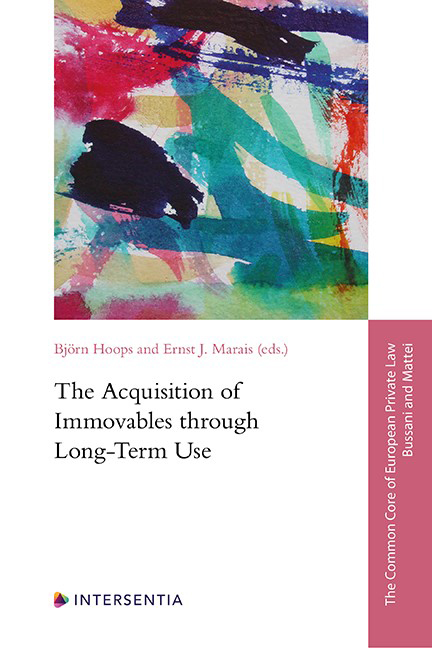Book contents
- Frontmatter
- General Editors’ Preface
- Preface
- Contents
- List of Cases
- Table of Legislation
- List of Abbreviations
- List of Contributors
- Case PART I INTRODUCTORY MATTERS
- PART II CASE STUDIES
- PART III GENERAL CONCLUSIONS
- Appendix I Instructions for the Project on the Acquisition of Immovables through Long-Term Use
- Index
Comparative Analysis – Case 5
Published online by Cambridge University Press: 26 May 2022
- Frontmatter
- General Editors’ Preface
- Preface
- Contents
- List of Cases
- Table of Legislation
- List of Abbreviations
- List of Contributors
- Case PART I INTRODUCTORY MATTERS
- PART II CASE STUDIES
- PART III GENERAL CONCLUSIONS
- Appendix I Instructions for the Project on the Acquisition of Immovables through Long-Term Use
- Index
Summary
GENERAL INTRODUCTORY REMARKS ON CASE 5
In the context of Case 5, many jurisdictions provide rules for acquisitions by unlawful users who are not intentional occupiers, often embodied by a ‘good faith requirement’. These rules may be substantially more lenient than those applicable to intentional occupiers. These jurisdictions thus foresee more than one basis for an acquisition of land through long-term use. This means that different legal bases for an acquisition must be considered and that it is possible that the user can rely upon any of these bases for his/her acquisition. For this reason, depending upon the legal basis discussed, these jurisdictions may feature in more than one group in this comparative analysis.
COMPARATIVE REMARKS ON VARIATION 5.1.
Variation 5.1. poses the question of whether the rules on acquisitions of land through long-term use treat small pieces of land along property boundaries differently from other land. The case also prompts an examination of the role played by the information on boundaries in the land information system. This inquiry concerns the owner of the adjacent land because Gregory moved the fence after consulting the land information system and gaining the (false) impression that the fence had been in the wrong place. The analysis of the reports with respect to the issue of whether Gregory has acquired the land reveals a very diverse picture.
(1) NO ACQUISITION THROUGH LONG-TERM USE WITHOUT THE REGISTRATION OF ANOTHER ACQUISITION
In the first group of jurisdictions, which consists of Germany, Finland, Scotland, and Sweden, an acquisition of land through long-term use is only possible with a preceding or concomitant registration of another, albeit defective, acquisition of the same land. An example would be the registration of the acquisition of the land through succession by a non-heir followed by the non-heir’s use of the land. These jurisdictions also apply this approach to small pieces of land along property boundaries. Gregory’s error and his long-term use would thus be irrelevant in these jurisdictions. Gregory has not acquired the land.
GREGORY WILL ONLY ACQUIRE UPON REGISTRATION
England and Wales under the Land Registration Act of 2002 are the only member of the second group of jurisdictions. While English and Welsh law do not permit an acquisition in Case 1, the boundary error in Variation 5.1.
- Type
- Chapter
- Information
- The Acquisition of Immovables through Long-Term Use , pp. 651 - 660Publisher: IntersentiaPrint publication year: 2022



